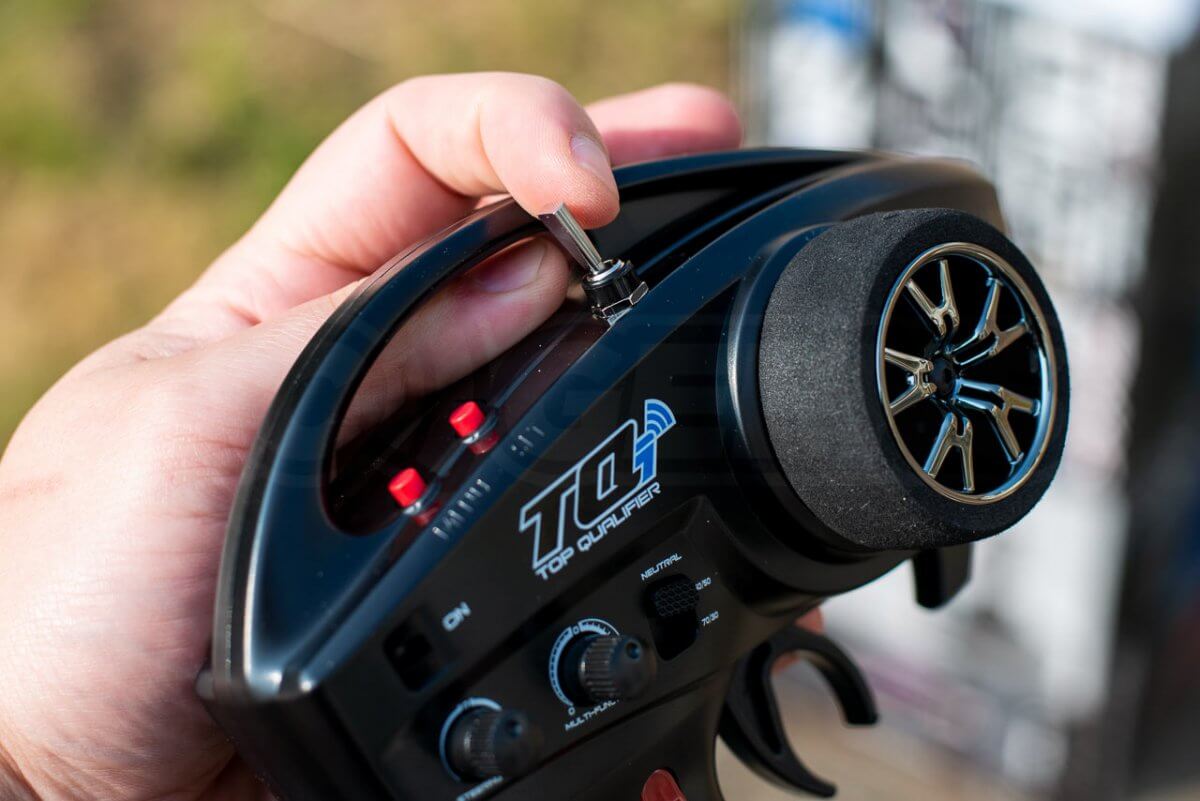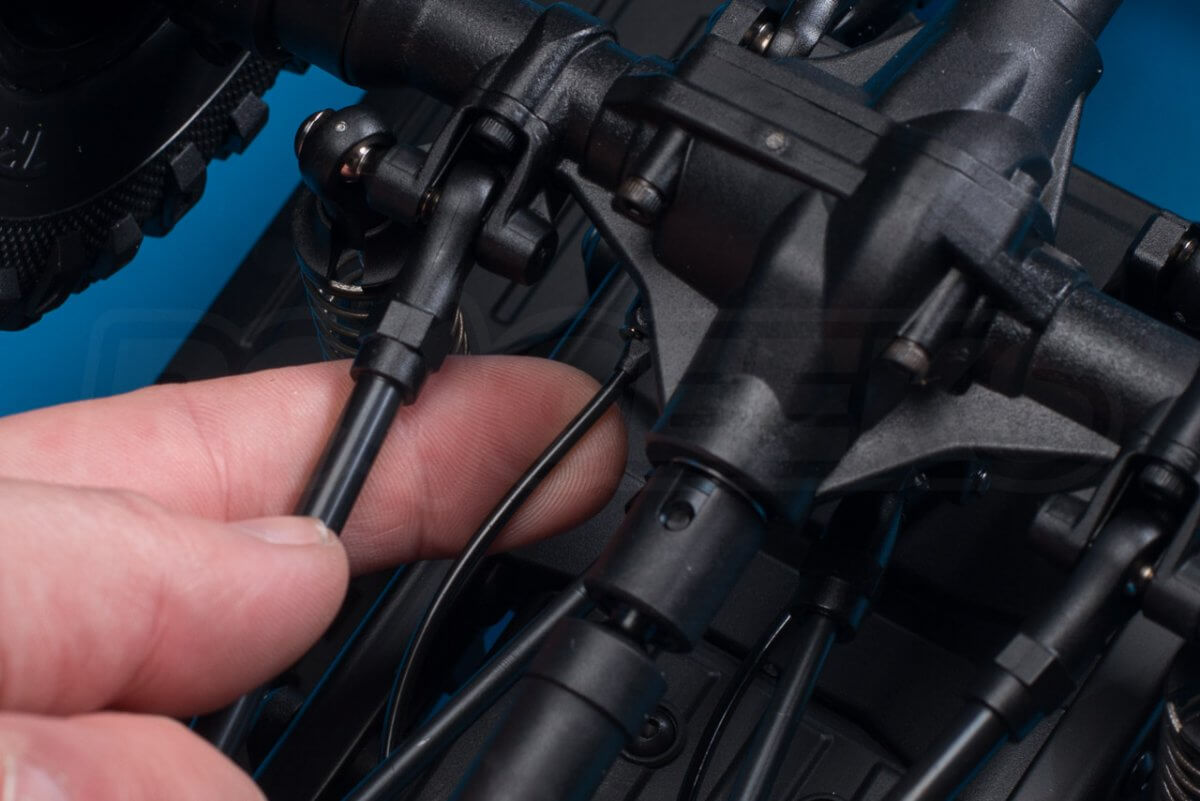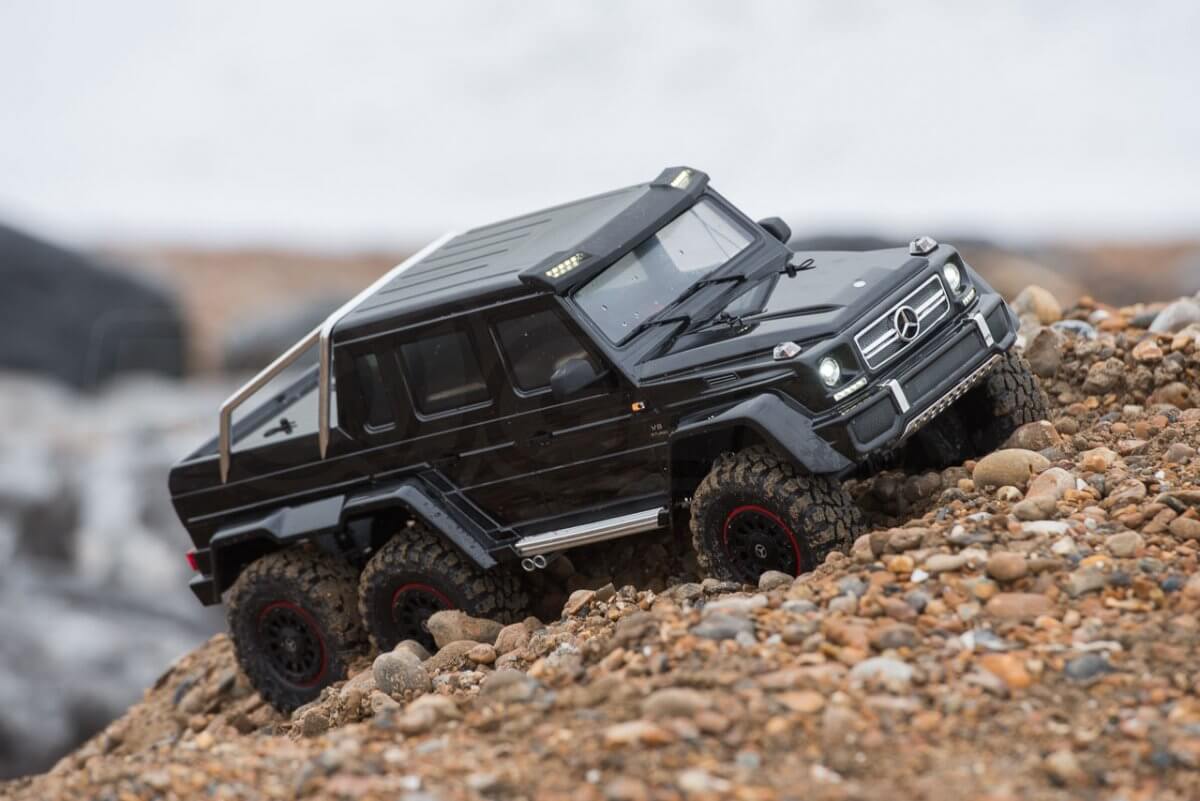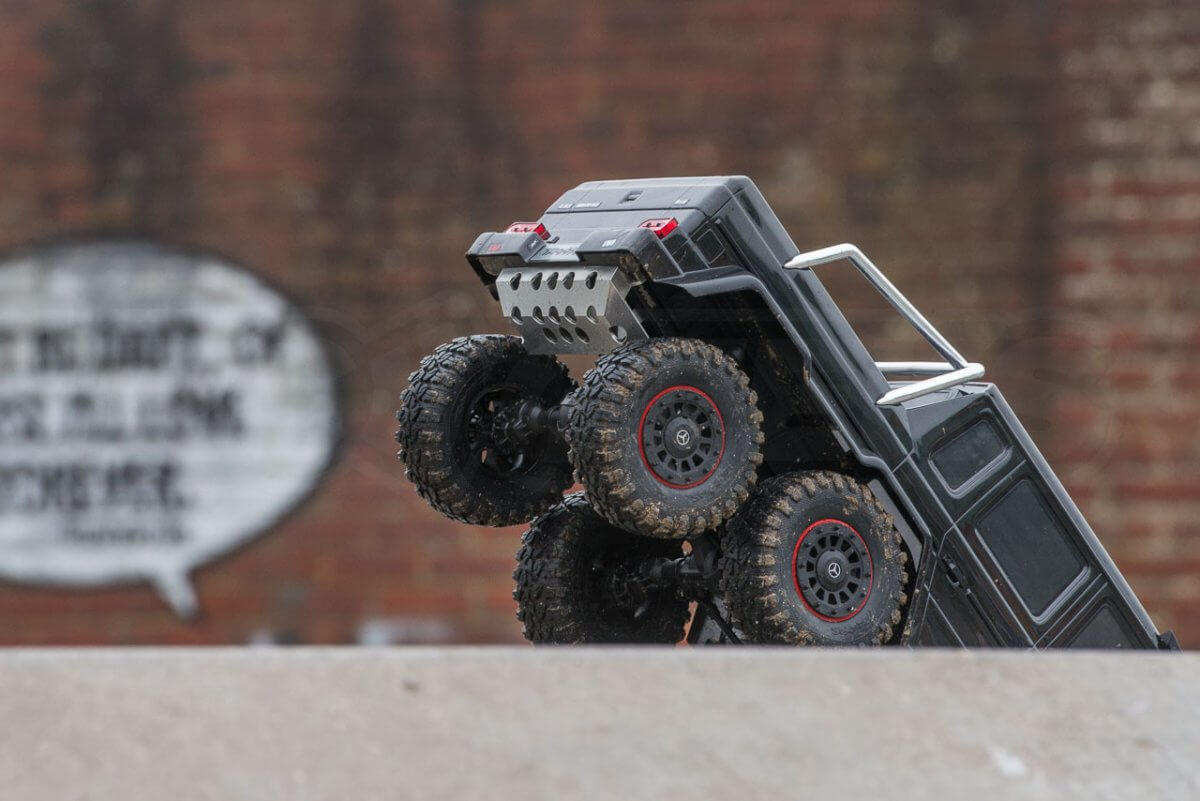Traxxas’ TRX-4 Land Rover Defender was our car of the year in 2017. Since then the american RC giants have released variations on the chassis with the Bronco/Blazer bodied releases, the cut-back Sport pickup and more recently the Traxx caterpillar modification. Perhaps in response to Axial’s UMG10, they are back with this latest revision, an elongated six-wheel-drive chassis: the TRX-6, Mercedes Benz G63 Edition!
The TRX-6 at a glance
- Ready-to-run scale RC Crawler
- Unique 6×6 drivetrain with remotely locking differentials
- Incredibly detailed Mercedes G63 AMG 6×6 body with factory light kit
- LiPo compatible XL-5 HV ESC
- Portal axles for maximum ground clearance
- 2.4Ghz 4-channel radio system (Traxxas link ready)
- 25cm wide, 27cm tall and a massive 65cm long, weighing 4kg
TRX-6 Unboxing
Little is different from the TRX-4 unboxing experience. Inside the (now longer) box is the factory-build chassis (with its beautifully finished body) sandwiched between two polystyrene blocks, the transmitter sat in a cutout at one end.

Also included are two spare body pins (on top of the four attached), a wheel wrench and three small allen wrenches, useful for making adjustments if you are new to the hobby and lack the tools. This is alongside the usual excellent Traxxas manual, warranty documentation and some stickers.

Whilst ready-to-run you will require a battery for the truck, a charger for that battery and 4x AA batteries for the receiver.
Quality TRX-4 parts
The TRX-6 is based on the fantastic TRX-4 chassis and thus shares a good 90% of its layout, components and electronics.

It is fitted with the same 550-sized, 21 turn, reverse rotation, brushed ‘Titan‘ motor. Ours has been drowned, hammered and even swapped in and out over 2 years of abuse and it is still going strong, a testament to its simple robust construction.
It also shares the XL5 HV electronic speed controller (ESC). This unit supports 3S power, has a black heatsink ontop, a regulated power output for the lighting module and its EZ-set button doubles as the power button.

The TQi™ 2.4GHz 4-channel transmitter supplied is a favourite of ours. Traxxas Link enabled, it can be upgraded with a bluetooth module that will give you live model telemetry on your smartphone.
Naturally it retains the 3-position diff lock switch as well as the cruise control feature, useful for extended trail driving. Overall it is a comfortable, reliable and most importantly responsive transmitter. At the car end a telemetry-ready 5-channel micro receiver with fail-safe is tucked into a waterproof box on the other side of the chassis to the ESC.

Slightly disappointingly Traxxas have retained their 2075X steering servo and its plastic servo horn. If you read our original review of the TRX-4 you will know that we killed both components in the first week. Traxxas offer an upgraded servo (with over 3 times the torque) and a metal horn as an upgrade, but we would have preferred to see them come included considering the raised retail price.

It retains same battery tray, mounted in the same central position as the TRX-4. You can squeeze a 5000mAh 3S 25c Traxxas battery in there for a long stint crawling. There is of course that small battery tray above the front axle that few actually use.
What’s new with the TRX-6?
More importantly, lets look at the changes Traxxas have made on this new model to accommodate two more driven wheels.
Articulated rear end
The overall length of the vehicle has increased by 14cm to fit the extra axle and wheels in. Even the distance between the intermediate axles has increased from 312mm to 324mm. The shot below compares the TRX-4 G63 chassis to its new longer brother.

Underneath you can see how the new system works, with a revised differential fitted to the central axle which now has a telescopic propshaft sticking out the back.

A new set of suspension mounts anchors the additional four-link setup attaching the last axle to the chassis, with another pair of shock-absorbers completing the set. Above deck the body post mounts have been shortened and shifted back to make way for the extra suspension turrets. An extra pair of wheel well light mounts have also been added for those who like to pimp out their chassis.

To ensure consistent performance, the rear axle also features a set of those fancy portal axles, maximising the clearance to that rear diff housing. The wheel arch liners have also been extended to stretch all the way over the new pairing.
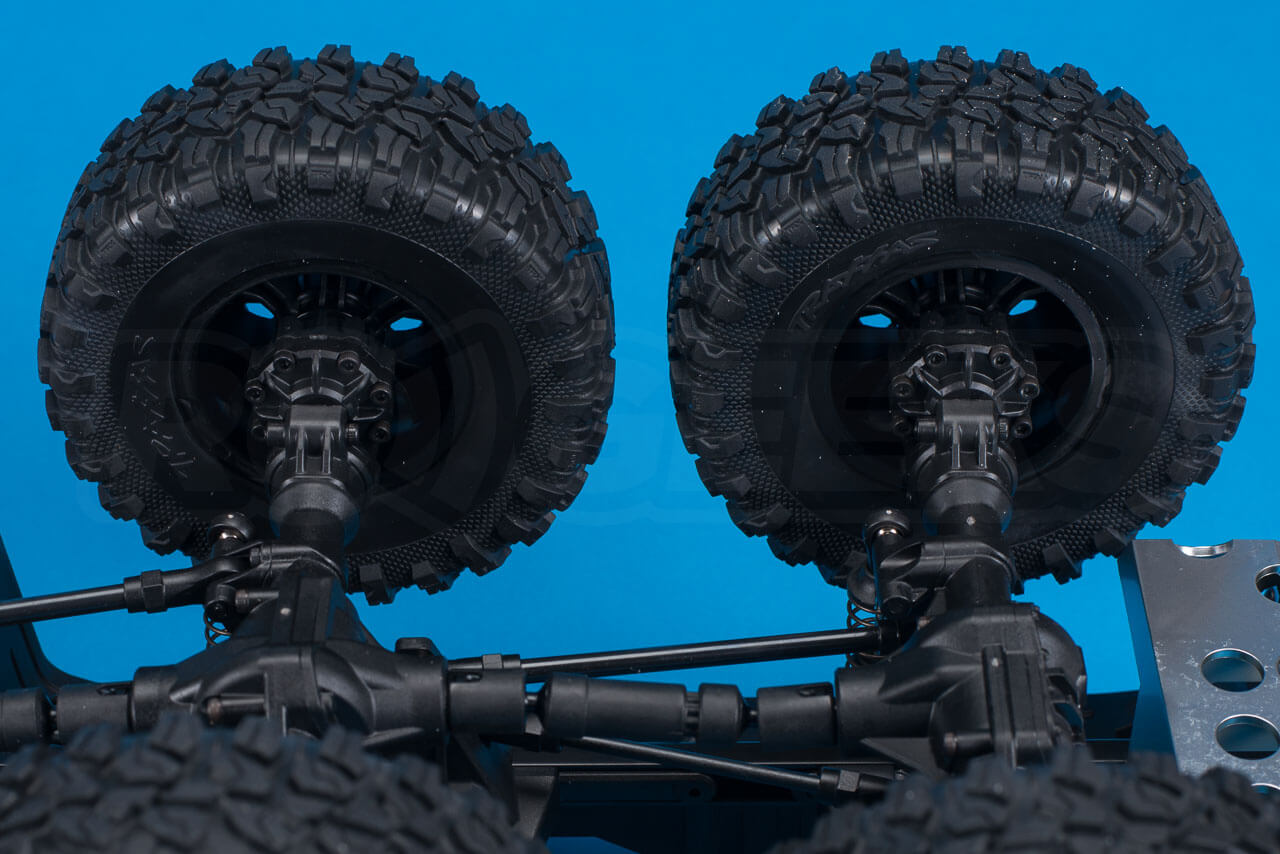
Remote differential lock
The TRX-4 introduced us to the joy of remotely locking differentials and the TRX-6 expands on this with its extra locking diff in the final axle.

Whilst there are actuation cables running to both the rear and the new final differential (see below), they both link up to the same micro-servo as you can see above.
The end result is that locking the ‘rear diff’ on the transmitter will simply lock both the rear axles at the same time. For the premium pricetag this truck wears, we would have liked to see some advancement of the system with a third micro-servo.
New wheels and tyres
We are glad to see that Traxxas has fitted this truck with a proper wheel and tyre set. The 2.2in all-terrain tyres are an S1 rubber compound. They are glued to the smaller beadlock (style) wheels over ‘trail-tuned’ foam inserts.
We aren’t that fond of the red lip, but the understated Mercedes logo on the wheel hubs is far superior to the huge poser ‘mall-crawler’ set that adorned the G63 4×4, seen below. Of all the TRX-4/6 wheels/tyres, our favourite still have to be the 1.9in Canyon Trail tyres fitted to the original Land Rover defender that enabled it to destroy any climb.

The metal hubs are still 12mm in size leaving you plenty of aftermarket options, but if you do upgrade just watch that outer diameter as not to foul the clearance between the rear pair!
Elongated pickup body
The officially licensed bodies are what set Traxxas cars apart from the competition on the trails. Thankfully this model is no different with exquisite detail from bumper to bumper. Our test unit was finished in a deeper metallic black than the 4×4 model, but the truck is also available in a metallic silver-grey which we’d probably opt for if it was our money.

A chrome coated plastic roll-cage sits upon the long deck, breaking up the lines and matching the chrome runners, grill, bumper inserts and front and rear skid plates. Chrome exhausts poke out from either side, extending underneath the chassis to faux silencers.

Authentic decals are employed throughout with the chrome 3-pointed star on the grill, Mercedes bonnet badge, V8 Biturbo markings, G63, 6×6 and AMG badging alongside the Traxxas vanity plate on the rear bumper.
This body comes with windows lightly tinted as opposed to the opaque stickers seen on the TRX-4 Land Rover Defender and we think it looks all the better for it.

Headlights, tail-light, side markers and bonnet running lights are all translucent coloured plastic, adding to the scale feel of the truck.
Standard light kit fitted
Following the popularity of the optional light kits on the Land Rover Defender, Traxxas have factory fitted the basic kit to this body. It includes LED headlights and running lights, corner markers on the bonnet, led lights on the front spoiler, orange side markers and red tail lights. These run off of a control box attached to the inside of the body, that in turn connects to a power breakout box connected to the ESC.
To add these yourself to the Mercedes G63 TRX-4 would cost £75, so including them as standard is a welcome move. If you wanted to add a light bar or the wheel well lights, there are still enough ports left on the lighting power box to do this.
Crawling with the TRX-6
We were super-eager to get testing this truck in the real world. Dodging the storms and torrential rain, we managed to test it on a variety of surfaces to get a true feel of how capable this premium crawler really is. Prepare for an overkill of images.
Straight away the extra axle comes into play. Crawling up over stepped yet uneven terrain, the truck use those extra two tyres at the back to push itself up. Thanks to its short overhangs, the TRX-6 has an approach angle of 60° and a departure angle of 55° allowing you to take on vertical walls when attacked at a slight angle. The cross articulation of (what is a narrow body) is entertaining to see with a much greater angle achievable between the front and rear wheels.
Check the droop on the rear axle as the truck climbs the bricks. That extra axle gives you two more driven points of contact with the floor, so pushing your way up steep objects results in success more times than you’d expect!

The extra weight of the additional axle and structure is as low as can be, retaining a similar centre of gravity and arguably improving stability with more weight over the rear end, something the TRX-4 definitely needed.

As mentioned we tested it with the 3S, 5000mAh cell packs that we have used on the other TRX-4 models. They weigh around 350g and sit centrally, if higher than is ideal.

Despite the front mounted motor the truck will still lift its front axle off of the ground. Where the TRX-4 would roll over backwards, the stabilising rear axle will balance things out, allowing you to continue to climb if not steer!

An awful lot of fun was had over our fortnight of testing. Quarry-like terrain is probably the most entertaining to attack with a mix of hard-packed stoney surfaces to climb.
We feel the longer, re-balanced chassis is certainly a better steer, even with the frankly weedy servo tucked up the front. Working your way up a gorge the front wheels are left largely just to directional duty whilst the rear diffs power the beast up the incline.
If you have read our Traxxas TRX-4 light installation you will know that the light kit fires up with the truck, by short-pressing the ez-set button the ESC. This can be done with the body in place (ideal considering the extra cabling on the lighting set) by carefully peeling the body up at the nearside exhaust and inserting a fingertip.
That large plastic windscreen visor adds to the tough look of the truck but also doubles up as a mount for even more LED lights, it also takes the brunt of any rollovers, saving the paintwork.

The TRX-4 will struggle on small shingle style rocks, where even the fully locked-out diffs would end up digging the wheels deeper into the loose terrain. The TRX-6 suffers less from this, but it isn’t immune. The only solution would be wider tyres at the expense of the scale looks.
We aren’t going to pretend that the TRX-6 is unstoppable, we had more than a few spills when trying to scale the damp sea defences resulting in the truck sliding sideways off of the rocks. The majority of our mistakes were exacerbated by the ESC, even in crawl mode the instant reverse comes on far too strongly, throwing the truck backwards.

When retrieving your truck from such a situation, avoid picking it up from the roll-cage as it is possible to tear it away from the body, instead grab from the bumpers or wheels.

Nearly all the reviews we have seen on the internet seem to take place in dry deserts, crawling the dry rocks of the Mojave Desert. Back in the UK our winters are a little wetter and markedly muddier, a suitably taxing test for this little truck.

It is here where the improved tyres (over the the stock Mercedes 4×4) really come into their own. The soft compound and wide tread blocks finding grip whilst we struggled to stay on our feet! With the differentials locked out it really was unstoppable.

For this review we opted to keep the truck stock but we can’t wait to see what it would be capable of on a set of the Canyon Trail 1.9in wheels or even some aftermarket combinations. With three pairs required we are really glad that manufacturers sell wheels and tyres in pairs instead of fours!

Despite the soft clay-like mud, the TRX-6 holds it own on the slopes. The active central axle stopping the truck from grounding out, whilst powering it up and over the slippery grass edges.
Its in situations like these where the limitations of the servo become apparent. The extra weight of the truck bears down on the front axle and even though the transmitter steering input is on full lock, the under-powered servo doesn’t have the torque to resist against the steering system. It is definitely number one on our list of upgrades.

Even cocked at this extreme angle with the front left wheel high in the air, four of the other wheels were in contact with the ground and the truck soldiers on. Interestingly the crawler brake-on-neutral feature of the ESC failed to hold the truck on this incline.

Its on wet days like this where the waterproof electronics come into their own, allowing you to confidently wade through streams and puddles.
Whilst we didn’t use the cruise control a great deal, the twin speed transmission is a lifesaver on a long drive. Opening the differentials and flicking the red switch on the transmitter allows the TRX-6 to crack along at a reasonable pace (around 9mph/14.5kmh) if nothing compared to a more traditional RC car.

Someone on our socials asked us if the TRX-6 could be jumped. Always up for a challenge, we took it to a local skatepark to see what we could achieve.
To tackle a half pipe you need to be in high gear mode and even then will need a run up. At that point the truck can manage a short hop out over the lip, not really ‘airing it out’, more of a cute hop/leap.
If you are crazy enough to want to properly jump it, you can swap in a brushless motor. Our converted TRX-4 land rover defender is still working fine a year of abuse on, a testament to the components Traxxas built that drivetrain with! One youtuber in the US has already converted his TRX-6 to 6S power and cracked 40mph with it.
Racing the truck around on a hard (if soaked) surface showed just how top-heavy the TRX chassis sadly still is. A hard turn at full speed would have it up on two wheels and eventually over onto its side, but it was never designed for high-speed handling.
Tackling the shorter ramps made for some more successful leaps, with the suspension hung down at full droop as the truck cleared a meter or so at a time. Most impressively despite several drops onto solid concrete (some of which on its roof) the Mercedes went home in one piece.
How does it compare to the TRX-4?
Lets start with the differences in specification. The 6×6 weighs 25% more than its older brother, coming in at just shy of 4kg.

As mentioned the overall length of the 6×6 Mercedes is 651mm compared to the 510mm of the 4×4. The wheelbase is 324/454mm front to mid/front to rear compared to 312mm on the 4×4, with a 2° difference in breakover angle 57° on the 6×6 to 59° on the 4×4. The newer truck is 13mm taller but the same width.

In real terms, the extra weight and drivetrain drag make for a lower top speed but in our opinion greater crawling capability. Whilst this particular pairing isn’t strictly a fair test due to the differences in wheel/tyre, it did give us a taste for the differences in balance and power.

Once the 4×4 model gained traction, it did genuinely feel lighter on the move, and sharper when steering around items whilst descending. However whenever the 4×4 chassis got stuck on a climbing challenge, the big 6×6 was there to shame it. That extra axle was like a cheat code when trying to climb a steep rock like the ones shown below.

Both models turned heads when we were out testing and crawling together but the 6×6 definitely generated the most questions/interest (and admittedly the biggest shock when the price was discussed!).
Who is it for?
We aren’t going to pretend, as an office originally full of X-Maxx ‘bashing’ fans, we had always looked down on crawling. At its release the TRX-4 changed all of that, our team smitten by the Defender’s fantastic detailed scale body and incredible capability. RC Crawling is a different challenge but one that really needs to be experienced to understand.

As such the TRX-6 is for everyone, young or old, who enjoys a ‘control’ challenge, negotiating an off road path without rolling over or getting stuck. The only true hurdle is the price. A retail of £800 before battery and charger will be a deal-breaker for many, especially when the TRX-4 chassis models can be picked up for as little as £460.

Should I buy the TRX-6?
If you don’t already have a TRX-4 and can afford it then yes. It really is that simple.
What are the alternatives?
Flippant remarks aside, Axial’s SCX10 II™ UMG10 6×6 is really the only competition out there. Considering how capable we found the SCX10 mk2 when testing, we have no reason to believe that the 6 wheel edition wouldn’t be as good. At around £450 it is quite a bit cheaper, but admittedly doesn’t look quite as cool.

We really want to see someone (if not Traxxas) modify the Land Rover Defender body to create a Defender 6×6 like this concept. Obviously if you already have a TRX-4 the decision to upgrade is not as clear cut. In our position we’d likely upgrade our TRX-4 wheel and tyre combo and enjoy an already fantastic chassis.
In conclusion
The TRX-6 is a fantastic truck and an evolution that we are glad Traxxas performed.
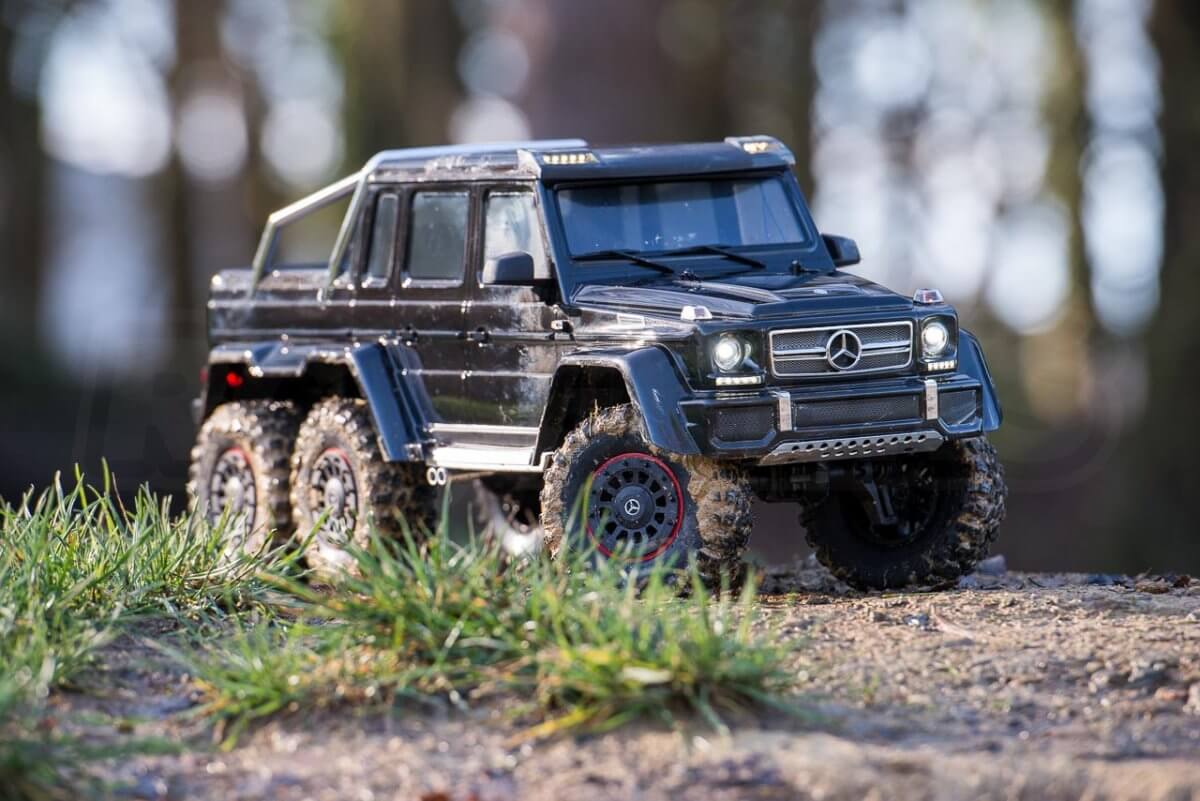
We love
- Incredibly capable : Builds on an already proven platform with added traction and weight.
- Ultimate scale crawler : This thing really turns heads, everyone wanted to know what it was when we were out testing it.
- Fully featured : Once you have driven with remote diff-locks you aren’t want to go back. They will get you out of a sticky situation without having to put your hands on your model.
- Flexible on the trail : The cruise control is cool but the extra gearbox is what makes this model liveable day to day, enjoyable everywhere
We dislike
- Weak steering : With the added weight of the extra axle, we are surprised that Traxxas didn’t opt to fit an upgraded servo or at least the metal servo horn found on other TRX models.
- Fragile body details : The bonnet markers and rear lights aren’t that secure and do come loose on the trail (the Mercedes body on the G63 TRX-4 also suffered from the same issue) whereas the Defender has stayed together after a year of abuse.
- Killer price : an RRP of £800 with no battery or charger will always be difficult to digest, but consider that the light kit is a £75 option for the standard TRX-4 Mercedes and is included here.
We really hope that Traxxas make the most of this new chassis, with more body options and potentially a ‘sport’ edition with permanently locked diffs for a little less money, as they did with the TRX-4.
Where can I buy the Traxxas TRX-6?
The Mercedes G63 edition is available in black (as pictured) or alternatively with a silver/grey body on our webstore.

Remember to pick up a charger and batteries at the same time. This combo with the EZ Peak plus charger and 3S 5000mAh LiPo is a simple and cost effective pacakge.
RC Geeks : Traxxas enthusiasts
We have been following the TRX developments ever since launch with a review of the original Defender-bodied chassis, a guide to fitting the official light kit, a review of the 4×4 G Wagon and even the Traxx caterpillar upgrade. Check out other traxxas articles on our site here.
Do you have any questions about the TRX-6, or want to see specific pictures of it? Perhaps you have bought one and want to share just how capable it is! Leave a comment in the section below.

